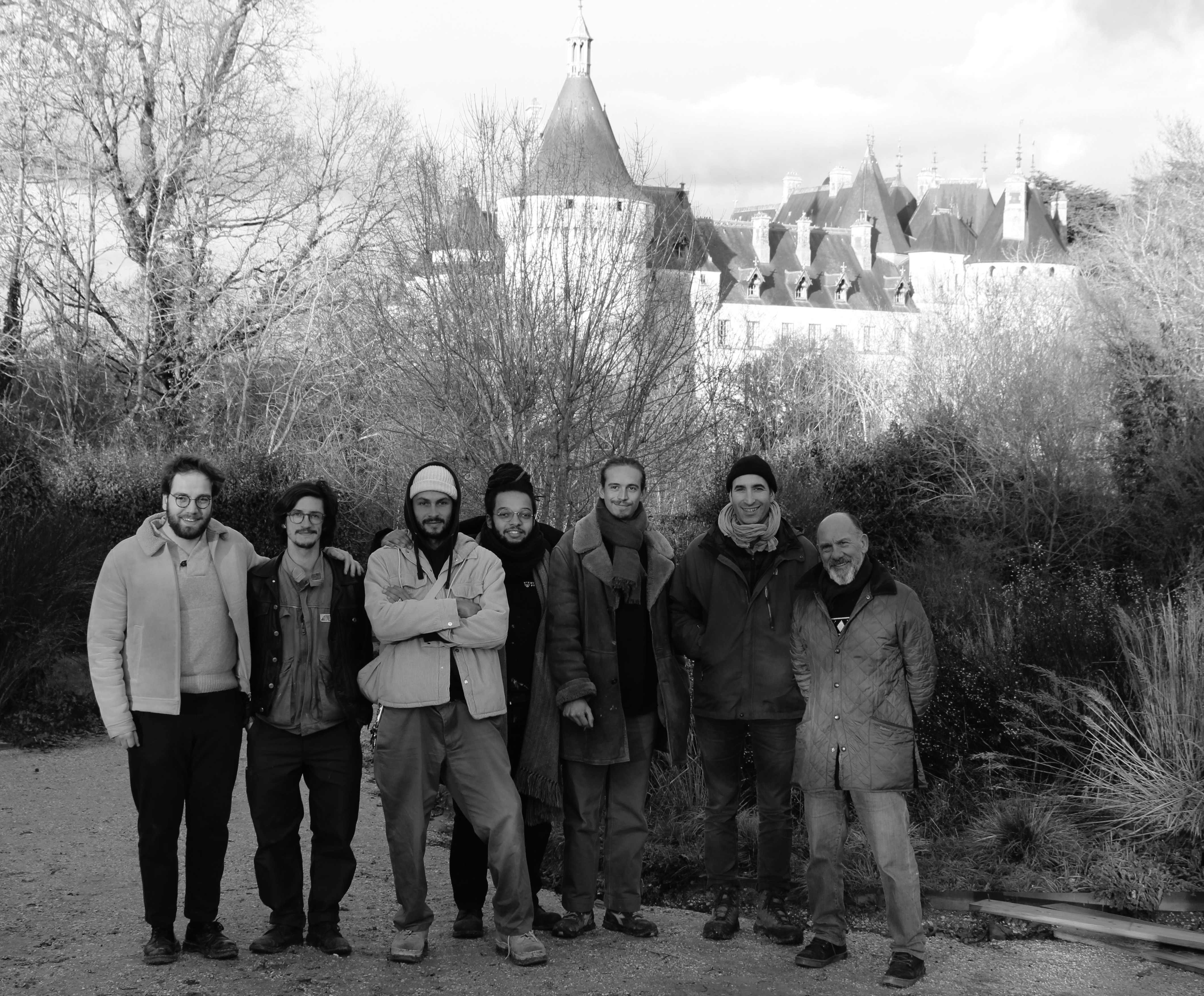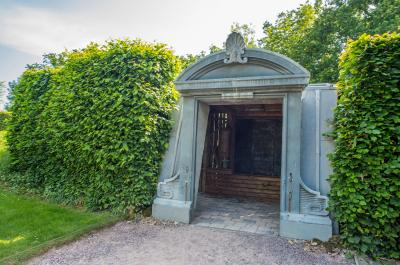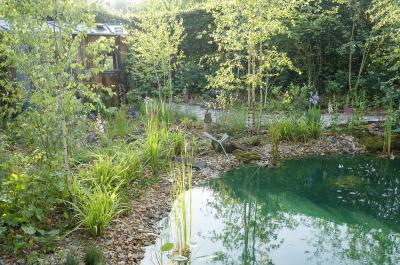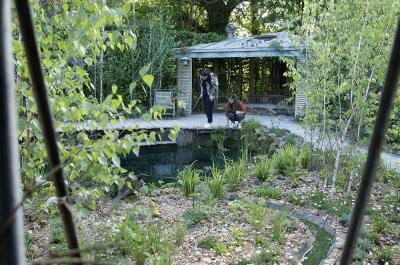13. Demain tout ira bien
Awarded on the 21st of June 2023 by a jury of professionals renowned in the world of garden art

“There’s a tree that grows in Brooklyn. Some people call it the Tree of Heaven. No matter where its seed falls, it makes a tree that struggles to reach the sky. It grows in boarded-up lots and out of neglected rubbish heaps. (…) It is the only tree that grows out of cement. It grows lushly… survives without sun, water, and seemingly without earth. It would be considered beautiful except that there are too many of it.”
Like the variety of ailanthus described by Betty Smith in her 1943 novel A Tree Grows in Brooklyn, this garden provides an example of resilience. This process, which follows a shock, doesn’t just consist of resisting the attack, it’s a “path” that you must take in order to accept the trauma, integrate it and get on with your life.
The shocks caused by climate change are all the more violent in urban areas were vegetation suffers from the growing use of concrete. The itinerary on offer in this garden attempts to create greater balance between vegetable and urban. Making its way through a depopulated area where pioneer plants are springing back to life, the path lead to an optimistic vision of the future. A water recovery system, composed of recycled zinc from the rooftops of Paris, makes the garden self-sufficient in resources. From its open shelters, shared with nature, it reasserts greater harmony between living things.
DESIGNERS

Fabien Caumont was drawn to gardens by his love of plants, which goes back to his early childhood. The son of a water and forest engineer and a mother with a passion for flowers and vegetable gardening, he grew up knowing the countryside codes by heart: common sense, observation, resourcefulness and a rhythm of life modelled on that of the earth. His first memories of gardens are indissociable from a childhood spent in the open air in contact with the plant kingdom. All those early experiences crystallised and led him to enrol at a major landscaping school. But the art of landscaping must be learnt by the hands as much as by the intellect, so he chose to carry out his studies while working in a variety of environments, including nurseries, creative companies and design offices in Paris and elsewhere. After graduating, he joined a well-known Paris firm, providing his private customers with comprehensive assistance in their garden projects. From rooftop gardens with views of La Défense to typically Parisian backyards where time seems to stand still, he always let himself be guided by a site’s quintessence when carrying out his projects. One of these Paris projects gave rise to a fortuitous collaboration (and friendship) with the founder of a design office based in New York, who offered him work “if one day he happened to be” in the city that never sleeps. The promise was kept when he moved to the United States with his family and lived there for a while learning valuable technical, botanical and intercultural lessons. Wishing to put down roots in more familiar soil, he then decided to return to his homeland to create a business in Paris and experiment in his country garden. An avid (almost compulsive) collector of books on landscape, from Russell Page to Roberto Burle Marx by way of René Pechère and Gertrude Jekyll, he often draws inspiration from his extensive library.
Francis Arsène grew up in a little village in Sarthe, the eighth child in a family of fifteen brothers and sisters. After obtaining his primary school certificate, a desire to work outdoors, and more specifically up high, set him on course for a career as a roofer and zinc worker. After his apprenticeship, he decided to follow his older brothers to the capital. In Paris, he was recruited by the company owned by Henri Charlent, known in particular for his Traité de Couverture (Treatise on Roofing), published in 1988. In 1981, he established his own business, Couverture GF, and went on to spend the next 35 years “traipsing” around the Parisian roofs he was renovating while training future roofers. In 1998, he set up Atelier Arzinc, removing old zinc from rooftops and recycling it into original creations that he incorporated harmoniously into Parisian gardens and interiors (tables, benches, chairs, ponds, water walls, window boxes, etc.). The L’Art du Jardin exhibition opened its doors to him and he discovered a world of enthusiasts there, providing it with his knowhow and technical expertise in a material that he knew like the back of his hand: zinc, which has the virtue of being highly resistant to weathering over the long term. Taking an approach to recycling that was innovative at the time, he succeeded in staying at the forefront of a school of thought on reuse that has now become indispensable. For several years now, he has been lending his assistance to a team of young architects fascinated by materials, who evolve day by day, drawing on the wealth of knowledge he communicates to them.
Thomas Marcel is a young architect with a degree from the Paris-La Villette National Higher School of Architecture (ENSA). After completing his studies, he spent two years honing his skills at the Atelier Parisien d’Urbanisme. As he had always been attracted to the world of crafts, he decided to change careers, teaching himself by working with matter in all its forms and using everything from wood to metal to create a range of furniture, architectural and design objects. He joined Atelier Arzinc in 2022, and is kept busy there fine-tuning his artisanal knowhow and creating unique pieces. Taking a resolutely creative approach, he wants to specialise in the design of objects, mastering his creative process from conception to completion.
Arthur Navecth grew up in Charente and studied architecture at the Paris-La Villette National Higher School of Architecture (ENSA), graduating as a State-certified architect in 2020. With a longstanding attraction to manual work, woodwork in particular (inherited from his carpenter father), he joined Atelier Arzinc at the end of his studies and trained as a zinc worker. Since then, he has mainly been active as a craftsman, oscillating been different materials depending on the nature of the project in hand: wood, steel and zinc in particular. His training as an architect also enables him to act as draughtsman and designer in interior layout projects. In addition to his professional activities, he’s an ardent music lover; he plays the saxophone in his spare time and has also been a member of a choir since 2014: the Chœur d’Hommes de la Villette, an association formed during his student days at Paris-La Villette ENSA. The contact with the world of landscape provided by his activities at Arzinc is still a joyful discovery today for a long-time balcony gardener.
After obtaining a Scientific Baccalaureate, Duncan Sidibé went on to take a double degree in architecture and engineering at the Paris-La Villette National Higher School of Architecture (ENSA) and the City of Paris Engineering School (EIVP). He carried out several placements over the course of his studies, including in repurposing in architecture at the Bellastock agency and in compressed-earth brick construction at Élémenterre in Senegal. For his End-of-Studies Project, he presented a plan to rehabilitate Dakar’s former international airport as a new neighbourhood combining housing, activities and agriculture in the city centre. An avid traveller, he makes a habit of visiting countries around the world in discovery of new landscapes and cultures, which he captures with the help of his talent in the field of film photography. He joined Atelier Arzinc in September 2021 and works there as craftsman/architect.
Camille Villemin is an architect qualified to manage projects in his own name (HMONP) with a degree from the Paris-La Villette National Higher School of Architecture (ENSA). In parallel with his architectural studies, he took a course in structural engineering at the Special School of Public Works, Building and Industry (ESTP). In 2014, during a year spent abroad on a Master’s degree course at the Bergen School of Architecture in Norway, he became interested in the world of crafts and shaping materials and taught himself how to use the tools in the carpentry workshop. Upon his return to France, he joined Paris-La Villette ENSA’s modelling workshop as assistant workshop manager, continuing in the post until he obtained his HMONP qualification in 2019. Alongside his studies, he continued his apprenticeship as a carpenter, training at the Decking & Décors carpentry firm in Var, where he was a computer-controlled CNC machine operator. During a placement as a worker at Couverture GF, he met Francis Arsène, who showed him the rudiments of the roofer-zinc worker’s profession via full renovation of the roofing of a building in rue Daguerre in Paris. Francis Arsène went on to open the doors of his Arzinc workshop to him, where he learned the techniques required for shaping zinc sheets and creating furniture inspired by the ornamental aesthetic of the Rooftops of Paris. Since 2020, he has been managing Atelier Arzinc projects, assisted by a team of fellow architects/craftspeople driven by a common determination to unify the design and realisation of their projects through craftsmanship.
Alexandre Wellers is a State-certified architect with a degree from Paris-Malaquais National Higher School of Architecture (ENSA) and a freelance craftsman. As an interdisciplinary practitioner of the architect’s profession, he works on his own behalf on eclectic projects combining architecture, object design and craftsmanship. He discovered the complexity and breadth of multidisciplinary practice at the FAAR Architecture agency, working on architecture, landscape and naval architecture projects. From design to worksite monitoring of architectural projects for private individuals, he has also worked at Atelier Arzinc since 2021, on conception and workshop manufacture of various custom-made items of furniture connected with the worlds of gardens and interior design. In parallel with his professional activities, he belongs to the Chœur d’Hommes de la Villette musical association’s group of amateur singers. He was a member of the team that designed and created the CHŒUR: le son dans l’espace spatial and acoustic exhibition held at Paris-la-Villette ENSA in 2019.






